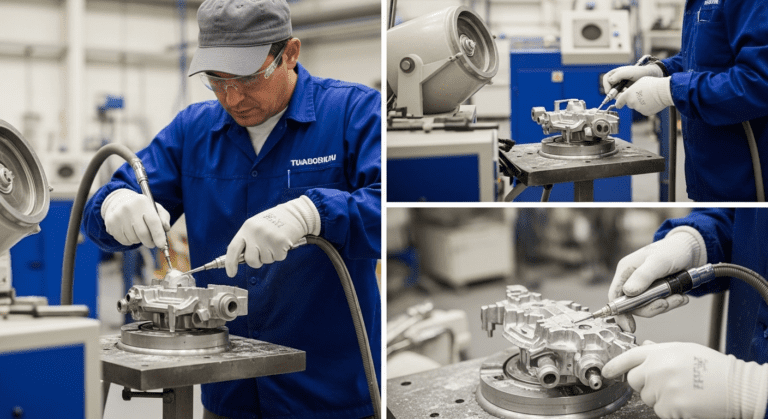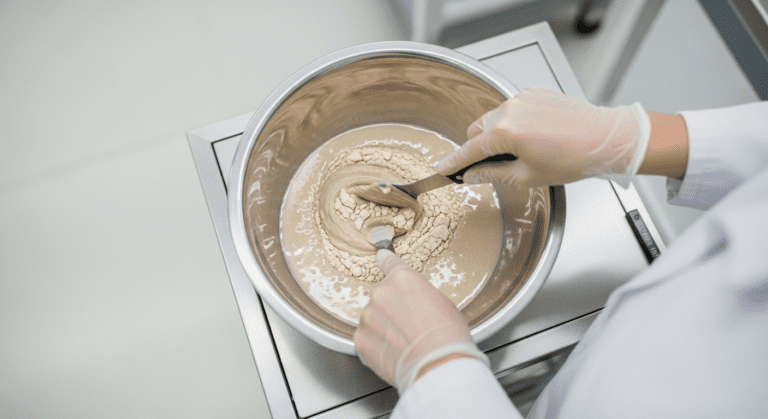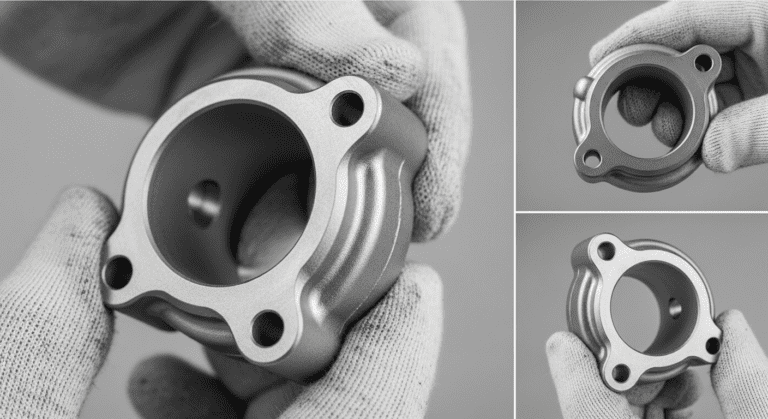TL;DR: Investment casting relies on specialized refractory materials that can withstand extreme temperatures while maintaining dimensional stability and chemical inertness. The industry primarily uses oxide ceramics (silica, alumina, zirconia, and zircon) for their widespread availability and excellent thermal properties, while non-oxide ceramics and novel composites address specific challenges when casting reactive metals.

| Material | Key Chemical Formula | Typical Melting/Max Use Temp (°C) | Typical Thermal Expansion (10⁻⁶/°C) | Typical Reactivity Profile | Typical Forms Used | Primary Investment Casting Applications/Alloy Suitability |
|---|---|---|---|---|---|---|
| Fused Silica | SiO₂ (Amorphous) | ~1750 | 0.5 – 0.55 | Good for Fe/Al, Reactive with Ti | Flour, Sand/Stucco | General purpose, ferrous & non-ferrous alloys, good dimensional stability |
| Quartz | SiO₂ (Crystalline) | Transforms < Fused Silica | Higher, complex | Similar to Fused Silica, less stable | Sand | Lower cost option, water glass systems for carbon/low-alloy steels |
| Fused Alumina (WFA) | Al₂O₃ | 2050 – 2250 | ~7.2 | Good for steels, many superalloys; some Ti/TiAl | Flour, Sand/Stucco | Ferrous, non-ferrous, superalloys, high-carbon steels, aerospace, Ti/TiAl (esp. high Al content) |
| Tabular Alumina | Al₂O₃ (Sintered α) | ~2050 | Low | High inertness | Grains, Powder | High-performance stucco, DS/SX superalloy casting |
| Mullite | 3Al₂O₃ · 2SiO₂ | ~1890 | Moderate | Good general inertness | Flour, Stucco | General commercial, good TSR, high-carbon steels (as electro-fused corundum) |
| Zircon | ZrSiO₄ | Dissociates >1670 | 2.5 – 6.0 (linear) | Good for steels, superalloys; reactive with Ti, some REs | Flour, Sand/Stucco | Prime coats for steels, Ni/Co-superalloys, aerospace, premium surface finish |
| Zirconia (Stabilized) | ZrO₂ | ~2700 (stabilized forms up to 2200-2400) | 8.8 – 9.5 | Very high inertness; some reaction with Ti-superalloys | Flour, Coatings, Sol | Reactive metals (Ti, TiAl), superalloys, precious metals |
| Yttria | Y₂O₃ | 2000 – 2200 | 7.2 – 8.2 | Exceptional for Ti/TiAl, care with Al-superalloys + SiO₂ binder | Flour, Coatings, Sol | Prime coat for Ti, TiAl (minimal alpha case); some reactive superalloys |
| Calcia | CaO | ~2600 | (Approximates superalloys) | Reactive with H₂O/CO₂; good with active molten metals | Powder, Additive | Potential cores, vacuum casting, Ti/TiAl casting (crucibles/additive) |
| Magnesia | MgO | 1790 – 1850 (refractoriness) | (0.8-1.2% linear exp.) | Good with Mg alloys, some Ni-alloys; volatilizes with Ti | Powder, Investment | Mg alloy casting (special conditions), modified for Ti casting |
| Graphite | C | Sublimes >3000 | Very Low | Inert to many metals (Ti, superalloys) in non-oxidizing atm. | Mold, Sand/Stucco, Powder | Ti-alloys, superalloys (non-oxidizing), permeability enhancement |
| Silicon Carbide | SiC | Dissociates ~2300-2700 | 4.0 – 5.8 | Good general inertness, attacked by some melts at high T | Powder, Components | Shells for dimensional accuracy/thermal stability, chills for Ni-superalloys, non-ferrous |
| Calcium Zirconate | CaZrO₃ | 2345 – 2368 | 10.45 – 11.05 | Excellent for Ti/TiAl | Powder, Slips, Molds | Reactive alloys (Ti, TiAl), silica-free systems |
| Barium Zirconate | BaZrO₃ | ~2700 | (No specific value) | Good for TiAl (often doped) | Crucibles, Powder | Reactive alloys (TiAl), often doped with Y₂O₃ |
Oxide Ceramics
Oxide ceramics form the backbone of investment casting refractory materials due to their excellent thermal stability and chemical inertness. These materials contain oxygen bonded with one or more metallic elements, providing unique properties suitable for various casting applications.
Silica-based Refractories
- Fused Silica: Characterized by extremely low thermal expansion (0.5×10⁻⁶/°C), fused silica provides exceptional thermal shock resistance and dimensional stability. It consists of amorphous SiO₂ produced by melting high-purity silica sand at temperatures exceeding 1700°C.
- Quartz Sand: Quartz sand offers an economical alternative for applications with less stringent dimensional requirements. With a higher coefficient of thermal expansion than fused silica, quartz undergoes multiple phase transitions during heating. At 573°C, α-quartz transforms to β-quartz, followed by transitions to tridymite and cristobalite at higher temperatures, each accompanied by volume changes.
Alumina-based Refractories
- Fused Alumina: Available as White Fused Alumina (WFA) and Brown Fused Alumina varieties, these materials offer superior hardness (Mohs 9) and abrasion resistance. WFA contains 99.5% Al₂O₃ and provides excellent chemical purity for reactive metal casting. Brown fused alumina, containing approximately 96% Al₂O₃ with iron oxide and titanium impurities, offers enhanced toughness at lower cost, making it suitable for backup layers in shell construction.
- Tabular Alumina: Manufactured through sintering process at temperatures up to 1900°C, tabular alumina features a distinctive tablet-like crystal structure that contributes to its exceptional thermal shock resistance. With low porosity (typically 3-5%) and high bulk density (3.5-3.65 g/cm³), it provides superior structural stability at elevated temperatures up to 1800°C.
- Aluminosilicates: These composite materials combine alumina (Al₂O₃) and silica (SiO₂) in varying ratios to achieve specific performance characteristics. Mullite (3Al₂O₃·2SiO₂) represents the key crystalline phase, containing approximately 72 wt% Al₂O₃ and 28 wt% SiO₂. Other aluminosilicates used in investment casting contain alumina percentages ranging from 42% to 72%. Fused corundum typically refers to high-alumina aluminosilicates used in particularly demanding applications where chemical resistance is essential.
Zircon
Zircon (ZrSiO₄) offers excellent thermal stability with a melting point of 2200°C and moderate thermal expansion (4.5×10⁻⁶/°C). Its high density (4.6-4.7 g/cm³) and superior surface finish characteristics make it particularly valuable for primary slurry coats.
Zirconia
Stabilized zirconia presents extraordinary refractoriness with a melting point of 2715°C, making it essential for ultra-high temperature applications. Available in monoclinic, tetragonal, and cubic crystalline forms, zirconia requires stabilization with additives like yttria, magnesia, or calcia to prevent destructive phase transformations.
Yttria
Yttria (Y₂O₃) represents the gold standard for reactive metal casting, particularly for titanium and titanium aluminides. With a melting point of 2425°C and unparalleled chemical inertness, yttria prevents oxygen transfer to oxygen-sensitive alloys.
Calcia
Calcia (CaO) offers excellent refractoriness with a melting point of 2572°C and serves as an important stabilizer for other refractory materials. Often employed in specialized applications requiring basic (non-acidic) refractory properties, calcia excels in casting specific alloy systems where silica and alumina may cause detrimental reactions.
Magnesia
Magnesia (MgO) provides exceptional high-temperature performance with a melting point of 2800°C and exhibits strong basic chemical characteristics. Its pronounced thermal expansion (13.5×10⁻⁶/°C) limits standalone applications but makes it valuable in composite refractory systems.

Non-Oxide Ceramics
Non-oxide ceramics offer alternative properties to traditional oxide-based refractories, providing solutions for specialized casting challenges through different chemical bonding mechanisms and physical characteristics.
Graphite (Carbon)
Graphite delivers exceptional thermal conductivity (25-470 W/m·K depending on quality and orientation) combined with low thermal expansion, creating superior thermal shock resistance for investment casting applications. Its non-wetting behavior with most molten metals prevents metal penetration defects, while its reducing atmosphere helps prevent oxidation of reactive alloys.
Silicon Carbide
Silicon carbide (SiC) combines exceptional hardness (Mohs 9-9.5) with outstanding thermal conductivity (120 W/m·K) and chemical durability. Available in alpha and beta crystalline polymorphs, SiC withstands temperatures up to 1600°C in oxidizing environments and considerably higher in inert atmospheres.
Novel and Composite Refractory Materials
Calcium Zirconate
Calcium zirconate, a perovskite-type oxide with the chemical composition CaZrO₃. With a melting point exceeding 2300°C and excellent phase stability, this material offers superior resistance to molten titanium and titanium alloys compared to traditional refractories. Its thermal expansion coefficient (9.7×10⁻⁶/°C) provides balanced performance in shell systems.
Barium Zirconate
Similar to calcium zirconate, barium zirconate represents another alkaline earth zirconate with a perovskite crystal structure, possessing the chemical composition BaZrO₃. This advanced refractory material offers exceptional thermal stability with a melting point exceeding 2600°C, surpassing even that of calcium zirconate.


